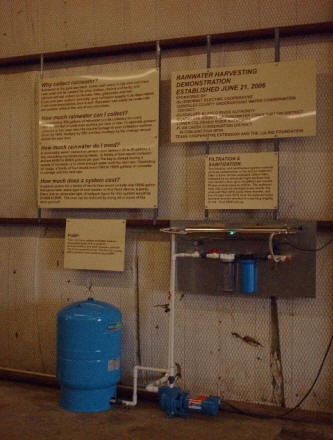|
Why collect
rainwater?
Rainwater is the gold standard. Unlike well water, it has zero
hardness. Less soap will be needed for your clothes, dishes
and body, and calcium will not collect on faucets, tiles,
glassware and hair. If you size your system correctly, your
rainwater supply is as dependable, if not more dependable, than
a well. Rainwater can easily be made safe and potable without
the use of any chemicals.
How much
rainwater can I collect?
Approximately 550 gallons of rainwater can be collected for
every 1000 square feet of collection surface per inch of rain.
To estimate amount collected in one year, take the square
footage of your collection surface, divide by 1000, multiply by
550 and then multiply by the average annual rainfall for your
area.
How much
rainwater do I need?
A reasonably water-conscious person uses between 25 to 50
gallons a day, excluding any landscaping needs. A family of
four would consume around 40000 to 80000 gallons per year. The
key to always having a supply of rainwater is to store enough
water until the next rain. Depending on usage, a family of four
would need 7500 to 15000 gallons of rainwater in storage until
the next rain.
How much does a
system cost?
A typical system for a family of two to four would include one
10000 gallon fiberglass tank, some type of roof washer or first
flush device, a pump, filters and an ultraviolet light. A
ballpark figure for this system would be $10000-$12000. The cost
can be reduced by doing all or some of the work yourself.
Collection
Surface and Gutters:
Metal roofs are ideal collection surfaces, but structures with
asphalt shingles, clay tiles and even cedar shingles can be
used. Estimate the size of the collection surface by measuring
the area of the footprint of the house. Gutters should be
screened to prevent large debris from entering the system.
 Roof
Washer: Roof
Washer:
A roof washer screens out gunk before it can enter your tank or
else diverts the first, dirtiest wash or water from the roof.
It is a critical component of potable systems and is also needed
to filter out small particles. A wide range of equipment is
available for different flow capacity and maintenance
requirements. Cost $500 and up.
Collection
Tank:
A fiberglass tank may not be as handsome as a metal or stone
cistern, but it provides versatility, hardiness and
affordability. One great feature is that the fittings are
integral to the tank, so there is no risk of leaking at these
vulnerable locations. Also, fiberglass tanks can be painted
with latex house paint to either camouflage or celebrate their
appearance. When placing your tank in position, remember that
water weighs over eight pounds per gallon. A 10,000 gallon tank
weighs over 40 tons, so it needs to be placed on a smooth,
level, stable foundation. The cost for a fiberglass tank made
with resins approved for potable water storage is about $6000.
Pump:
There are many options available, from an economical pump that
is great for do-it-yourselfers to a more powerful unit that has
an increased flow rate. The cost for a pump with a pressure
tank starts at about $500.

Filtration and
Sanitation:
The filtration and sanitization system consists of three
components: a five micron sediment filter, a three micron
activated carbon filter, followed by an ultraviolet light
sanitizer that can handle a flow up to 12 gallons per minute.
Proper maintenance is critical. The sediment filter ($3) must
be changed every month, the charcoal filter ($10) every three
months, and the UV light bulb ($75) must be replaced every
fourteen months whether it is burning brightly or not. Cost
$800 and up.
To schedule tours for groups or
individuals please contact The Luling Foundation office
at (830) 875-2438 or at
lulingfoundation@sbcglobal.net
|